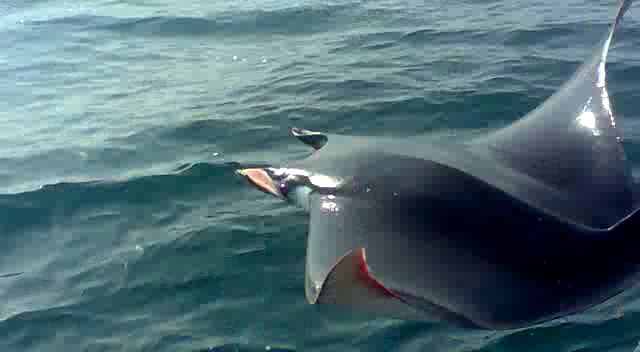
KARACHI: A trained skipper [boatman], Badsha Nawab, released a five-foot-long spinetail mobula entangled in the tuna gillnet laid down near Ras Zarrien in Pasni, Balochistan. This is the third mobulid ray safely released by fishermen since last year.
The first mobulid ray was released on May 26, 2014, whereas a large one was released on August 23 this year.
Mobulid rays are important marine animals whose population is under serious threat mainly due to overfishing, habitat degradation and their very slow reproductive pattern.
Read: Limbless reptile: Ten-feet-long python killed at Lawrence Gardens
Considering their importance, the World Wide Fund for Nature-Pakistan (WWF-Pakistan) initiated an awareness programme for fishermen and trained them to safely release these charismatic and gentle marine animals.
There is an international concern that mobulid rays are slow to mature — they take more than eight to 10 years — have long lives of up to 40 years but they reproduce very slowly. A manta ray will give birth to a single pup every two to five years. These rays are known for their charismatic beauty, gentle behaviour, and inquisitive playful nature. For this reason, tourists spend nearly $140 million every year to see these rays in the wild, providing an important source of income to many countries.
One of the reasons for their decline is the emerging demand for ray gill plates in the traditional Chinese medicine. Although not scientifically proven to have any health benefits, the demand for gill plates has compelled fishermen in some of the countries to target mobulids. Luckily, gill plates of mobulids are not exported from Pakistan but still mobulids are regularly being caught as by-catch of gillnet fisheries in Pakistan.
WWF-Pakistan senior director Rab Nawaz considered the safe release of these rare animals as a good omen for the fisheries of Pakistan. Wildlife lovers are rejoicing that fishermen are now concerned about protecting threatened species found in Pakistan. “They have to lose a part of their costly fishing nets to get the endangered marine animal released,” he said.
WWF-Pakistan’s Mohammad Moazzam Khan said that the mobula rays or mobulids include large species of fish, closely related to sharks and sting rays. “The mobulids can grow to very large size with some manta ray individuals reaching up to nine metres wide.”
These fish are commonly found in the warmer, tropical of waters of the world's oceans. Manta rays are graceful swimmers and their short tail allows the manta ray to have more acrobatic movement and they have even leap out of the water.
According to WWF-Pakistan’s officials, there are six species of mobulids belonging to two genus - Manta and Mobula – that have been reported from Pakistan. Giant manta (Manta birostris) is the largest of the mobulids found in Pakistan. This species were found more commonly before 1970 with some of the specimens going up to seven metres across disc breadth. There were a number of records of this species either basking or leaping out of water behind Charna Island, however, these species had not been sighted for 30 years.





















1713272658-0/Copenhagen-fire-(1)1713272658-0-270x192.webp)
















COMMENTS
Comments are moderated and generally will be posted if they are on-topic and not abusive.
For more information, please see our Comments FAQ